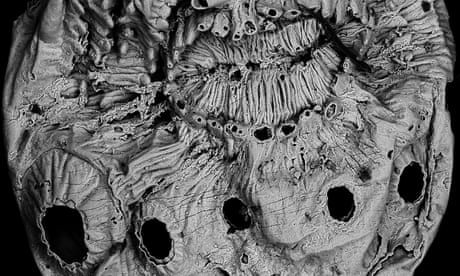One less relative to be embarrassed about – scientists have ruled out the possibility that a 535m-year-old microscopic fossil that looks like an “angry minion” is our earliest known ancestor. Previous research had suggested that Saccorhytus coronarius, a tiny sack-like creature , was an early member of a large group of animals called the deuterostomes, which vertebrates – including humans – belong to. Now researchers say they are confident that Saccorhytus is not a deuterostome, but part of the same evolutionary group as arthropods, which includes insects and crustaceans.
Sign up to First Edition Free daily newsletter Archie Bland and Nimo Omer take you through the top stories and what they mean, free every weekday morning Privacy Notice: Newsletters may contain info about charities, online ads, and content funded by outside parties. For more information see our Privacy Policy . We use Google reCaptcha to protect our website and the Google Privacy Policy and Terms of Service apply.
A huge mouth and no anus – this could be our earliest known ancestor Read more “The paper suggested that Saccorhytus was an early member of our own evolutionary lineage, a group of animals known as the deuterostomes. But we had specimens that were better preserved, so we knew immediately that the authors had got it flat-out wrong,” said Philip Donoghue, a professor at the University of Bristol and co-author of the latest study published in Nature. The team recently collected hundreds of additional specimens, which they used to create 3D digital models of the creature and that revealed microscopic features in more detail.
“ Saccorhytus is only about a millimetre in size and looks like a tiny wrinkly ball with a bunch of spines and a mouth with rings of teeth around it,” said Donoghue. “I like to describe it as an angry minion. ” The discovery was made when the team realised that the spines and holes around the fossil’s mouth were not respiratory organs, which is what misled the previous researchers.
“The previous conclusion was based largely on the fact that Saccorhytus fossils have a series of holes around their mouth, which they interpreted as primitive gills, a feature of deuterostomes. But we now know that these holes are simply where teeth have broken away,” said Donoghue. “Our analysis suggests that Saccorhytus is actually a member of the group that arthropods and their relatives are part of, called the ecdysozoans, although we can’t say for sure exactly where it fits in.
” Whereas deuterostome embryos develop an anus followed by a second hole that becomes the mouth, Saccorhytus only has one opening, which serves as both. “ Saccorhytus does not have an anus, only a mouth-like structure where it would have happily let anything it had eaten back out again,” said Donoghue. The search for our earliest ancestor continues, Donoghue said.
“Our understanding of the deuterostome lineage is in an absolute mess. We are working our way through early fossils to gain a better understanding of our evolution,” he added. Dr Imran Rahman, a principal researcher at the Natural History Museum, said: “This is a really nice study that convincingly overturns the original deuterostome interpretation of Saccorhytus coronarius .
”.
From: theguardian
URL: https://www.theguardian.com/science/2022/aug/17/angry-minion-with-no-anus-not-related-to-humans-after-all-scientists-conclude



